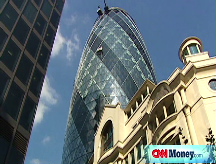Stocks surge near year end
Wall Street gains in a thinly-traded session at the end of an abysmal year.

NEW YORK (CNNMoney.com) -- Wall Street surged Tuesday in an end-of-the-year bargain buying spree as investors scooped up a variety of shares hit hard in the 2008 stock market battering.
The Dow Jones industrial average (INDU) rose 2.2%. The Standard & Poor's 500 (SPX) index gained 2.4% and the Nasdaq composite (COMP) rose 2.7%.
All three major gauges jumped in the first few minutes of the session on news that the government will pour $6 billion into GMAC Financial Services, the financing arm of struggling automaker General Motors.
The advance lost some steam after the release of weak economic reports, but then recharged as the session wore on.
"We're seeing a nice little rally in the last few sessions of the year, with everyone kind of just waiting for the year to be over," said John Wilson, chief technical strategist at Morgan Keegan.
With one trading day left in 2008, the Dow is down 34.7%, the S&P 500 39%% and the Nasdaq around 41.5%.
"I think people are anticipating a January rally and are trying to get in ahead of that," said Ron Kiddoo, chief investment officer at Cozad Asset Management.
Wilson said that he thinks that the start of the new year should bring in more buyers and that stocks could see a bigger rally then. The lows of the fall were the lows of this bear market and the market is bottoming or has bottomed, he believes.
Since bottoming on Nov. 20, stocks, as measured by the S&P 500, have rallied 18%.
"When you look at past bear markets and recession, stocks tend to turn six or nine months before the economic data bottom, and I think that's what we're seeing now," he said.
Kiddoo said he thinks that 2009 will be an up year, but added that he's not convinced a rally will kick in as soon as January.
Economy: Investors seemed to take a barrage of weak economic readings in stride on Tuesday.
The S&P Case-Shiller index showed new home sales plunged 18% in October, a record decline. Prices in top 20 markets it measures have plunged for 27 months in a row.
The Conference Board's Consumer Confidence index plunged to 38 in December, an all-time low, as the recession and stock market meltdown took its toll on sentiment. Confidence stood at a reading of 44.7 in November. Economists surveyed by Briefing.com expected confidence to improve modestly to 45.5.
The Chicago PMI, a regional reading on manufacturing, was little changed in December from November's recessionary levels. PMI rose to 34.1 from 33.8, versus forecasts for it to drop to 33.
General Motors: The government said late Monday that it will pour $6 billion into GMAC. GMAC is the financing arm of GM and seen as critical to its survival.
The decision to help GMAC is the latest move by the government to bail out the battered auto industry. President Bush announced a $17.4 billion rescue package less than two weeks ago to help GM (GM, Fortune 500) and Chrysler avoid bankruptcy.
GM (GM, Fortune 500) shares gained 5%, while rival Ford Motor (F, Fortune 500) gained 1%.
Gains were broad based, with 28 out of 30 stocks advancing.
Market breadth was positive. On the New York Stock Exchange, winners topped losers by four to one on volume of 960 million shares. On the Nasdaq, decliners topped advancers two to one on volume of 1.46 billion shares.
Bonds: Treasury prices dipped modestly, raising the corresponding yield on the benchmark 10-year note to 2.28% from 2.25% Monday. Treasury prices and yields move in opposite direction. Yields on the 2-year, 10-year and 30-year Treasurys all hit record lows last week.
Lending rates were mixed. The 3-month Libor rate slipped to 1.44% from 1.46% Monday, according to Bloomberg. The overnight Libor rate edged up to 0.14% from 0.12%. Libor is a key bank lending rate. (Full story)
Other markets: In global trading, Asian markets ended mixed, while European markets gained.
The dollar fell against the euro and yen.
U.S. light crude oil for February delivery fell 99 cents to settle at $39.03 a barrel on the New York Mercantile Exchange, after gaining 13% over the previous two sessions.
COMEX gold for February delivery fell $5.30 to settle at $870 an ounce.
Gasoline prices fell 0.3 cent to a national average of $1.616 a gallon, according to a survey of credit-card swipes released Tuesday by motorist group AAA.
2008 market meltdown: With one session left, Wall Street is currently on track to close out its worst year since the 1930s.
The Dow's decline of nearly 35% is the third worst ever, following a decline of 52.7% in 1931 and 37.7% in 1907. The S&P's decline of 39% is the second worst ever, following the 47% decline the index saw in 1931.
For the Nasdaq, this year's loss of 41.5% is the tech-fueled index's worst ever, going back to its inception in 1971.
All 10 of the economic sectors, as measured by Standard & Poor's, posted substantial losses this year. The worst performer was financials, which lost nearly 60%. The so-called "best" performer was consumer staples, which lost 19.5%.
Only 15 of the S&P 500 stocks ended the year with gains, led by Family Dollar Stores (FDO, Fortune 500), which rose 27%. The S&P 500's biggest loser was AIG, which lost 97%.
28 of 30 Dow stocks ended lower, led by GM, which lost nearly 86%. The Dow's two gainers were Wal-Mart Stores (WMT, Fortune 500), which added 16% and McDonald's (MCD, Fortune 500), which added 2.5%. ![]()






